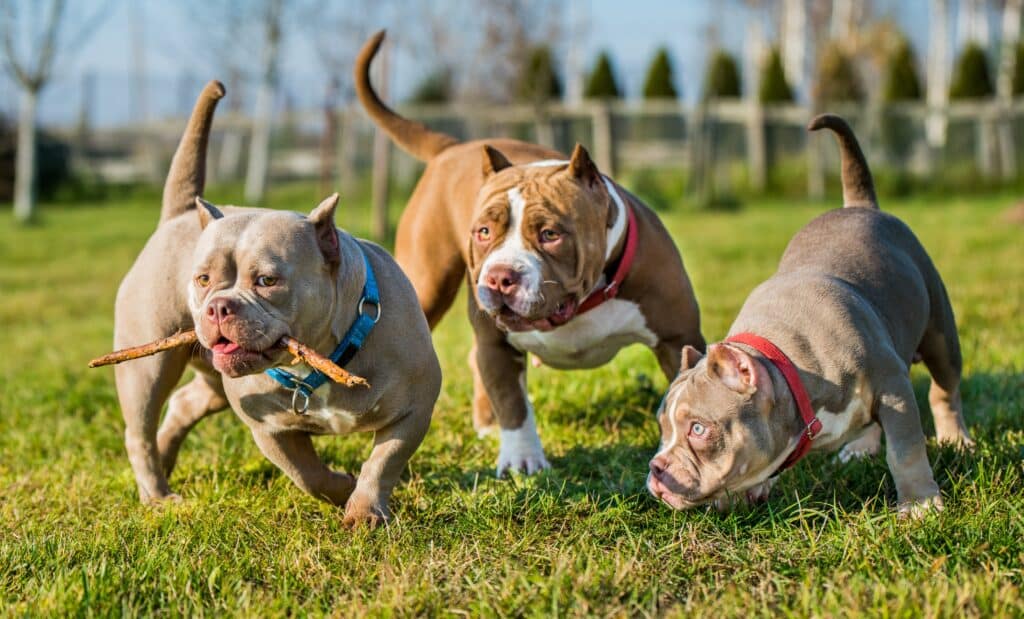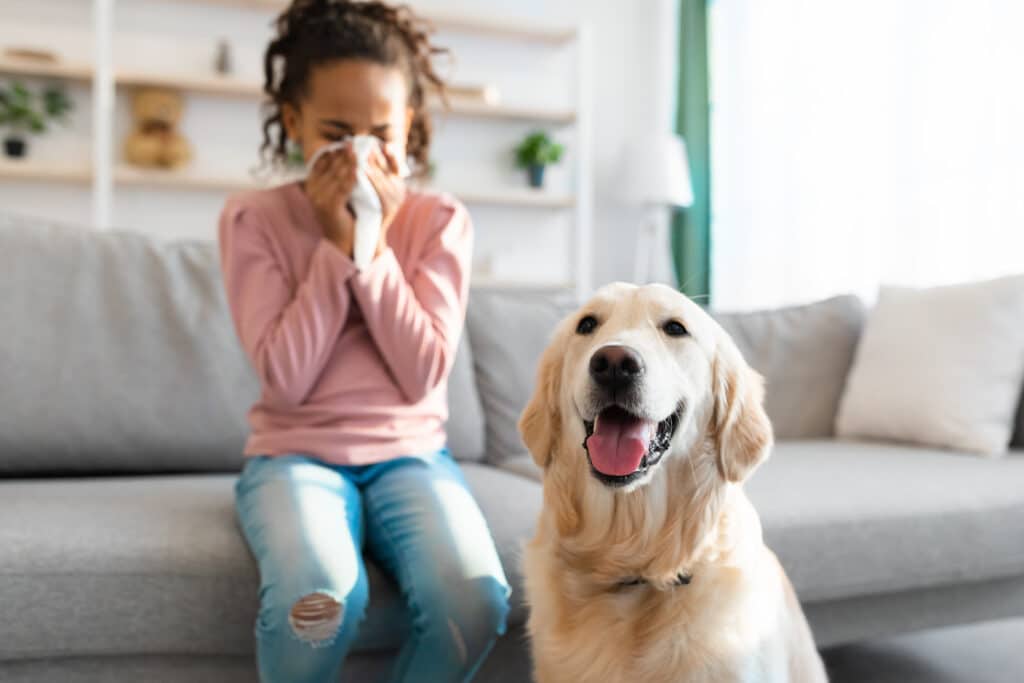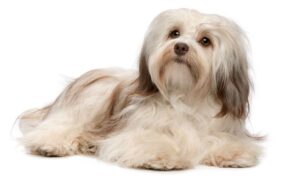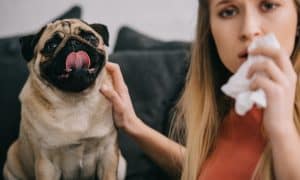“This post contains affiliate links, and I will be compensated if you make a purchase after clicking on my links.”
You’re strongly considering getting a dog. But then you find out that you or someone that you reside with may be allergic. Is that the premature end of your dreams of being a fur parent?

Not necessarily. Statistically, this is not uncommon, as 1 in 5 pet owners is (or is close to someone who is) allergic to pets.
This doesn’t mean that allergies can be ignored; rather, there are steps that you can take to mitigate the risk of allergic reactions. Especially when there is a plethora of hypoallergenic dog breeds you can choose from.
Dander refers to the “flecks of skin shed by cats, dogs” and is akin to dandruff for humans. Pet hair, contrary to common perception, is not an allergen. But it can collect and carry allergens.
When pets move around the house, the tiny and lightweight dander go into the air and can stay afloat for a significant amount of time. Breathing in these particles can cause allergic reactions in people who are sensitive to these triggers.
What Are Hypoallergenic Dogs?
For dogs, the “hypoallergenic” designation is given to breeds that don’t shed as much.
Given that dogs shed their top layer roughly every 21 days, and some breeds are double-coated, that’s a lot of potential hair and dander!
Less shedding means less hair and dander, which consequently means less allergens floating around your home. In addition, hypoallergenic dog breeds have the added benefit of requiring less frequent cleanup since there’s less shedding.
And to be clear, there is no such thing as an allergy-free dog, as anything that has fur or feathers will produce allergens. However, hypoallergenic dog breeds are your best bet if you’re looking to minimize the allergens around the house.
100 Hypoallergenic Dog Breeds

Take a look at the list below, with a 👍 next to the ones with the LEAST shedding:
- Affenpinscher 👍
- Afghan Hound
- Airedale Terrier
- American Bulldog 👍
- American Hairless Terrier 👍
- American Leopard Hound
- American Staffordshire Terrier
- Anatolian Shepherd
- Australian Terrier 👍
- Barbet
- Basset Fauve de Bretagne
- Basenji 👍
- Bavarian Mountain Scent Hound 👍
- Bedlington Terrier
- Belgian Malinois
- Bergamasco Sheepdog
- Bichon Frise
- Biewer Terrier 👍
- Black Russian Terrier
- Bluetick Coonhound
- Bolognese 👍
- Boston Terrier
- Bouvier des Flandres 👍
- Braque du Bourbonnais
- Briard 👍
- Brussels Griffon
- Bullmastiff 👍
- Cairn Terrier
- Cesky Terrier 👍
- Chihuahua
- Chinese Crested
- Chow Chow 👍
- Cirneco dell’Etna
- Cockapoo 👍
- Coton de Tulear 👍
- Dandie Dinmont Terrier
- Dogo Argentino 👍
- Fila Brasileiro
- Fox Terrier
- German Longhaired Pointer
- German Shorthaired Pointer
- German Wirehaired Pointer
- Giant Schnauzer
- Glen of Imaal Terrier Dog 👍
- Goldendoodle
- Hamiltonstovare 👍
- Hanoverian Scenthound
- Havanese
- Irish Terrier
- Irish Water Spaniel 👍
- Italian Greyhound
- Kerry Blue Terrier 👍
- Komondor
- Kyi-Leo
- Labradoodle
- Lagotto Romagnolo 👍
- Lakeland Terrier
- Lhasa Apso
- Löwchen
- Maltese
- Maltese Shih Tzu 👍
- Maltipoo 👍
- Miniature Pinscher
- Miniature Schnauzer
- Mountain Cur
- Norfolk Terrier 👍
- Norwich Terrier
- Old English Sheepdog 👍
- Papillon
- Peekapoo
- Peruvian Inca Orchid
- Pharaoh Hound
- Polish Lowland Sheepdog 👍
- Poodle 👍
- Portuguese Water Dog 👍
- Puli 👍
- Russkaya Tsvetnaya Bolonka
- Saluki
- Schnauzer 👍
- Schnoodle
- Scottish Terrier
- Sealyham Terrier
- Shichon
- Shih Tzu
- Silken Windhound
- Silky Terrier
- Soft Coated Wheaten Terrier
- Spanish Water Dog
- Tibetan Terrier 👍
- Tibetan Mastiff
- Toy Poodle
- Vizsla
- Welsh Terrier
- West Highland Terrier
- Wire Fox Terrier
- Wire-haired Pointing Griffon 👍
- Whippet
- Xoloitzcuintli 👍
- Yorkipoo 👍
- Yorkshire Terrier
Things To Do To Prevent Allergic Reactions From Dogs

As mentioned previously, hypoallergenic does not mean allergen-free, but rather that the pet generally produces fewer allergens compared to others of the same species.
This doesn’t mean that every dog in the breeds listed above will be compatible with your situation. Each dog is unique, and you might find that the individual who has allergies strongly reacts to one dog but has no reaction to another dog of the same breed. Thus, the below should be considered as general guidelines.
To find out for sure what works best for your specific needs, it is advised for everyone who will be co-inhabiting with the pet to meet the pet together. This will allow two things:
- You’ll see how the pet reacts to everyone.
- You’ll see how your everyone reacts to the pet. The visit may uncover allergies that they previously weren’t aware of.
To further mitigate the risk of allergic reactions, here are some other steps you can take as per The Humane Society:
- Diet: Ensuring that your pet has a high quality diet has innumerable benefits, one of which is less shedding! Unlike high quality fresh dog food, lower quality dog food is full of fillers that don’t contain the nutrients your dog needs to maintain a healthy coat.
- Grooming: De-shed your pet regularly with tools that help remove the loose hairs/undercoat. This will reduce the amount of hair that’s shed.
- Bathing: Bathe your pet more routinely, even weekly, to reduce the amount of dander on your pet. This will help reduce the amount of dander spread throughout the home as your pet moves around. Make sure you use a shampoo that is specifically formulated for dogs.
- Filters: Remove pollutant and allergens floating in the air with HEPA filters
- Cleaning: Clean articles that dander can cling onto, such as curtains, couch covers, and pillows more frequently. This will help decrease the amount of dander present in your home. Vacuuming is also important, especially if you have rugs or carpet flooring, as dander can accumulate there.
Conclusion
Hypoallergenic dogs are great choices for those who may be concerned about allergic reactions but are strongly considering a dog. With so many beautiful varieties to choose from, you’ll have no trouble falling in love with one (or many) to add to your family.
For the corresponding full guide on hypoallergenic cats, check out: Your Ultimate Guide to Hypoallergenic Cat Breeds
About the Author: Lily Dee is a writer at The Pawsome World, a site dedicated to sharing valuable content that will allow pets and their owners to live their best lives. Being a pet parent isn’t always easy, and The Pawsome World provides tips/hacks as well as heartwarming content that pet lovers can rely on. To learn more about The Pawsome World, visit thepawsomeworld.com. Also follow on IG for daily doses of pet-related happiness: www.instagram.com/thepawsomeworld/
























[…] We had the opportunity to guest post this article on The Dogington Post, please check it out here: Your Ultimate Guide to Hypoallergenic Dog Breeds […]